UNITED STATES
SECURITIES AND EXCHANGE COMMISSION
WASHINGTON, D.C. 20549
FORM 8-K
CURRENT REPORT
Pursuant to Section 13 or 15(d)
of the Securities Exchange Act of 1934
Date of Report (Date of earliest event reported): April 25, 2024
FTI CONSULTING, INC.
(Exact Name of Registrant as Specified in Its Charter)
| Maryland | 001-14875 | 52-1261113 | ||
| (State or Other Jurisdiction of Incorporation) |
(Commission File Number) |
(I.R.S. Employer Identification No.) |
| 555 12th Street NW, Washington, D.C. 20004 (Address of principal executive offices) (Zip Code) |
Registrant’s telephone number, including area code: (202) 312-9100
(Former name or former address, if changed since last report)
Check the appropriate box below if the Form 8-K filing is intended to simultaneously satisfy the filing obligation of the registrant under any of the following provisions:
| ☐ | Written communications pursuant to Rule 425 under the Securities Act (17 CFR 230.425) |
| ☐ | Soliciting material pursuant to Rule 14a-12 under the Exchange Act (17 CFR 240.14a-12) |
| ☐ | Pre-commencement communications pursuant to Rule 14d-2(b) under the Exchange Act (17 CFR 240.14d-2(b)) |
| ☐ | Pre-commencement communications pursuant to Rule 13e-4(c) under the Exchange Act (17 CFR 240.13e-4(c)) |
Securities registered pursuant to Section 12(b) of the Act:
| Title of each class |
Trading Symbols(s) |
Name of each Exchange on which Registered |
||
| Common Stock, par value $0.01 per share | FCN | New York Stock Exchange |
Indicate by check mark whether the registrant is an emerging growth company as defined in Rule 405 of the Securities Act of 1933 (§230.405 of this chapter) or Rule 12b-2 of the Securities Exchange Act of 1934 (§240.12b-2 of this chapter).
Emerging growth company ☐
If an emerging growth company, indicate by check mark if the registrant has elected not to use the extended transition period for complying with any new or revised financial accounting standards provided pursuant to Section 13(a) of the Exchange Act. ☐
| ITEM 2.02. | Results of Operations and Financial Condition |
FTI Consulting, Inc. (“FTI Consulting”) uses a presentation from time to time in its discussions with investors and analysts (the “Presentation”). The Presentation includes FTI Consulting’s past and present financial results, operating data and other information. A copy of the Presentation is furnished as Exhibit 99.1 and has been posted to the FTI Consulting website at www.fticonsulting.com.
| ITEM 7.01. | Regulation FD Disclosure |
In the Presentation, FTI Consulting uses information derived from consolidated and segment financial information that may not be presented in its financial statements or prepared in accordance with generally accepted accounting principles in the United States (“GAAP”). Certain of these measures are considered “non-GAAP financial measures” under rules promulgated by the Securities and Exchange Commission. Specifically, FTI Consulting has referred to the following non-GAAP financial measures:
| • | Total Segment Operating Income |
| • | Adjusted EBITDA |
| • | Total Adjusted Segment EBITDA |
| • | Adjusted EBITDA Margin |
| • | Adjusted Net Income |
| • | Adjusted Earnings per Diluted Share |
| • | Free Cash Flow |
FTI Consulting has included the definitions of “Segment Operating Income” and “Adjusted Segment EBITDA,” which are financial measures presented in accordance with GAAP, in order to more fully define the components of certain non-GAAP financial measures. FTI Consulting evaluates the performance of its operating segments based on Adjusted Segment EBITDA, and Segment Operating Income is a component of the definition of Adjusted Segment EBITDA. FTI Consulting defines “Segment Operating Income” as a segment’s share of consolidated operating income. FTI Consulting defines “Total Segment Operating Income,” which is a non-GAAP financial measure, as the total of Segment Operating Income for all segments, which excludes unallocated corporate expenses. FTI Consulting uses Segment Operating Income for the purpose of calculating Adjusted Segment EBITDA. FTI Consulting defines “Adjusted Segment EBITDA” as a segment’s share of consolidated operating income before depreciation, amortization of intangible assets, remeasurement of acquisition-related contingent consideration, special charges and goodwill impairment charges. FTI Consulting uses Adjusted Segment EBITDA as a basis to internally evaluate the financial performance of its segments because FTI Consulting believes it reflects current core operating performance and provides an indicator of the segment’s ability to generate cash.
FTI Consulting defines “Total Adjusted Segment EBITDA,” which is a non-GAAP financial measure, as the total of Adjusted Segment EBITDA for all segments, which excludes unallocated corporate expenses. FTI Consulting defines “Adjusted EBITDA,” which is a non-GAAP financial measure, as consolidated net income before income tax provision, other non-operating income (expense), depreciation, amortization of intangible assets, remeasurement of acquisition-related contingent consideration, special charges, goodwill impairment charges, gain or loss on sale of a business, and losses on early extinguishment of debt. FTI Consulting defines Adjusted EBITDA Margin as Adjusted EBITDA as a percentage of total revenues. FTI Consulting believes that the non-GAAP financial measures, which exclude the effects of remeasurement of acquisition-related contingent consideration, special charges and goodwill impairment charges, when considered together with its GAAP financial results and GAAP financial measures, provide management and investors with a more complete understanding of FTI Consulting’s operating results, including underlying trends. In addition, EBITDA is a common alternative measure of operating performance used by many of FTI Consulting’s competitors. It is used by investors, financial analysts, rating agencies and others to value and compare the financial performance of companies in FTI Consulting’s industry. Therefore, FTI Consulting also believes that these measures, considered along with corresponding GAAP financial measures, provide management and investors with additional information for comparison of its operating results with the operating results of other companies.
FTI Consulting defines “Adjusted Net Income” and “Adjusted Earnings per Diluted Share” (“Adjusted EPS”), which are non-GAAP financial measures, as net income and earnings per diluted share, respectively, excluding the impact of remeasurement of acquisition-related contingent consideration, special charges, goodwill impairment charges, losses on early extinguishment of debt, non-cash interest expense on convertible notes and gain or loss on sale of a business. FTI Consulting uses Adjusted Net Income for the purpose of calculating Adjusted EPS. Management of FTI Consulting uses Adjusted EPS to assess total company operating performance on a consistent basis. FTI Consulting believes that these non-GAAP financial measures, when considered together with its corresponding GAAP financial results and GAAP financial measures, provides management and investors with an additional understanding of its business operating results, including underlying trends.
1
FTI Consulting defines “Free Cash Flow” as net cash provided by operating activities less cash payments for purchases of property and equipment. We believe this non-GAAP financial measure, when considered together with our GAAP financial results, provides management and investors with an additional understanding of FTI Consulting’s ability to generate cash for ongoing business operations and other capital deployment.
Non-GAAP financial measures are not defined in the same manner by all companies and may not be comparable with other similarly titled measures of other companies. Non-GAAP financial measures should be considered in addition to, but not as a substitute for or superior to, the information contained in FTI Consulting’s Consolidated Statements of Comprehensive Income. Reconciliations of Non-GAAP financial measures to the most directly comparable GAAP financial measures are included in the Presentation.
The information included herein, including Exhibit 99.1 furnished herewith, shall not be deemed to be “filed” for purposes of Section 18 of the Securities Exchange Act of 1934, as amended (the “Exchange Act”), or otherwise subject to the liabilities of that section, nor shall it be incorporated by reference into any filing pursuant to the Securities Act of 1933, as amended, or the Exchange Act, regardless of any incorporation by reference language in any such filing, except as expressly set forth by specific reference in such filing.
| ITEM 9.01. | Financial Statements and Exhibits |
(d) Exhibits
| 99.1 | 2024 First Quarter Investor Presentation of FTI Consulting, Inc. | |
| 104 | The Cover Page from FTI Consulting’s Current Report on Form 8-K dated April 25, 2024, formatted in Inline XBRL. | |
2
SIGNATURES
Pursuant to the requirements of the Securities Exchange Act of 1934, as amended, FTI Consulting, Inc. has duly caused this report to be signed on its behalf by the undersigned thereunto duly authorized.
| FTI CONSULTING, INC. | ||||||
| Dated: April 26, 2024 | By: | /s/ CURTIS P. LU |
||||
| Name: | Curtis P. Lu | |||||
| Title: | General Counsel | |||||
3
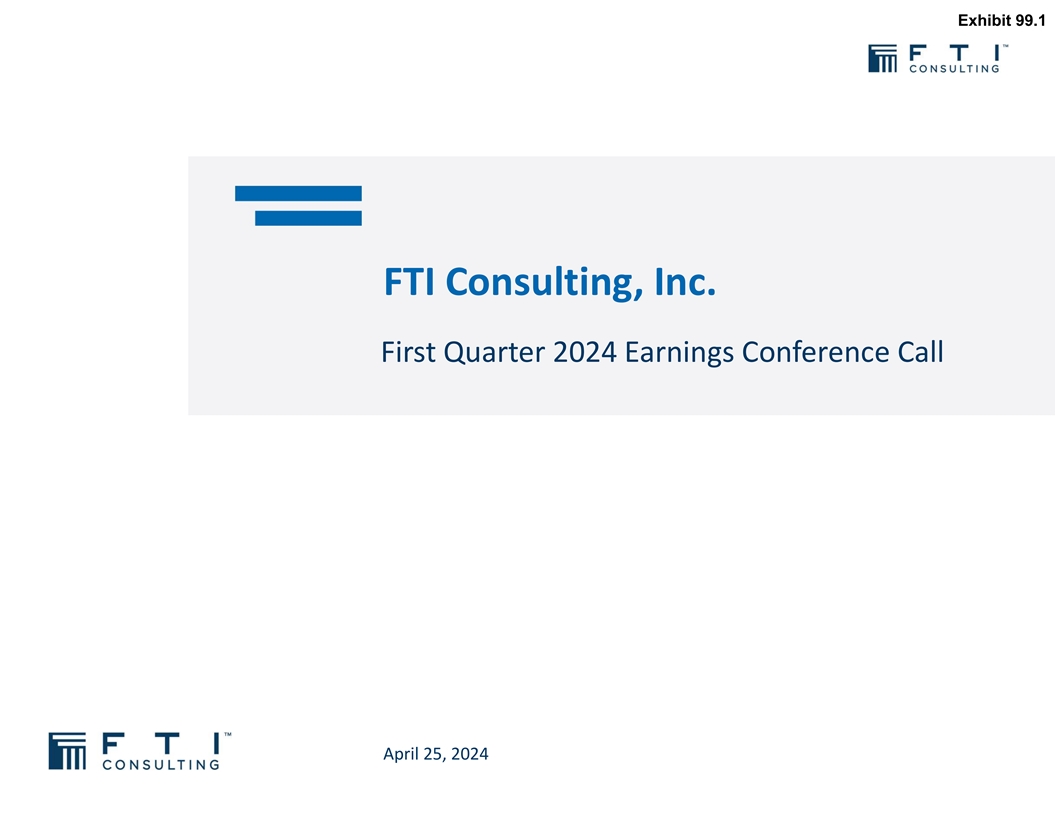
Exhibit 99.1 FTI Consulting, Inc. First Quarter 2024 Earnings Conference Call April 25, 2024
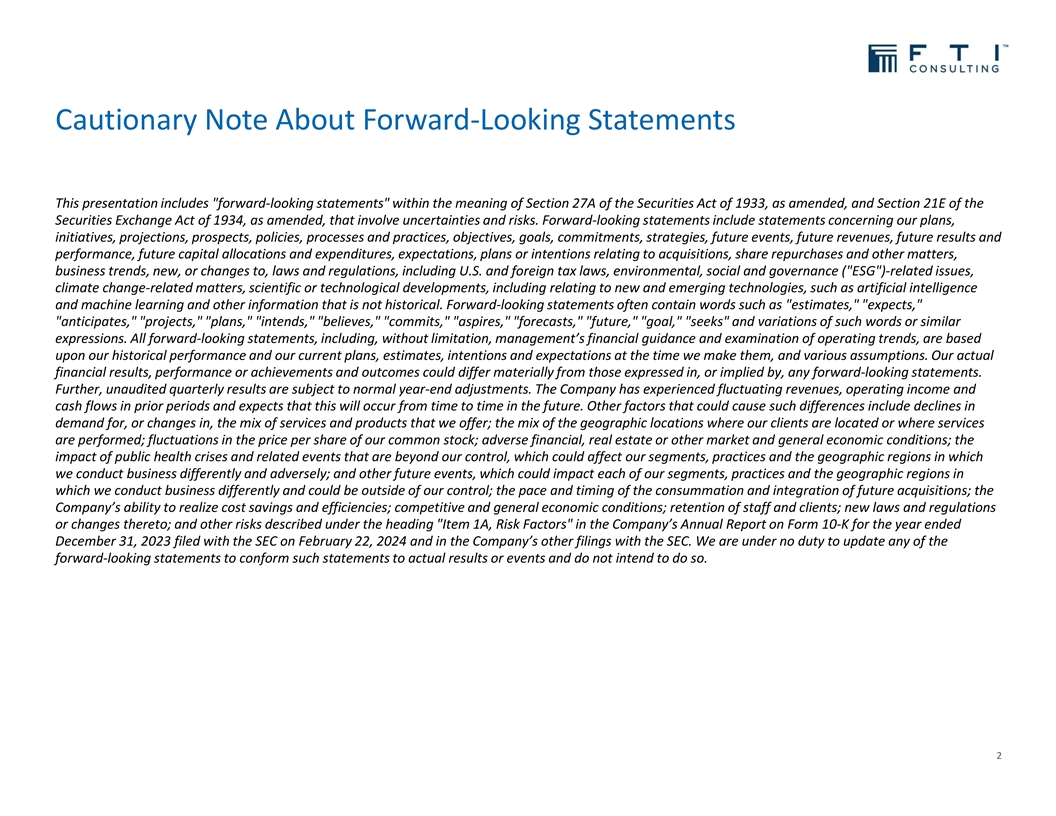
Cautionary Note About Forward-Looking Statements This presentation includes forward-looking statements within the meaning of Section 27A of the Securities Act of 1933, as amended, and Section 21E of the Securities Exchange Act of 1934, as amended, that involve uncertainties and risks. Forward-looking statements include statements concerning our plans, initiatives, projections, prospects, policies, processes and practices, objectives, goals, commitments, strategies, future events, future revenues, future results and performance, future capital allocations and expenditures, expectations, plans or intentions relating to acquisitions, share repurchases and other matters, business trends, new, or changes to, laws and regulations, including U.S. and foreign tax laws, environmental, social and governance ( ESG )-related issues, climate change-related matters, scientific or technological developments, including relating to new and emerging technologies, such as artificial intelligence and machine learning and other information that is not historical. Forward-looking statements often contain words such as estimates, expects, anticipates, projects, plans, intends, believes, commits, aspires, forecasts, future, goal, seeks and variations of such words or similar expressions. All forward-looking statements, including, without limitation, management’s financial guidance and examination of operating trends, are based upon our historical performance and our current plans, estimates, intentions and expectations at the time we make them, and various assumptions. Our actual financial results, performance or achievements and outcomes could differ materially from those expressed in, or implied by, any forward-looking statements. Further, unaudited quarterly results are subject to normal year-end adjustments. The Company has experienced fluctuating revenues, operating income and cash flows in prior periods and expects that this will occur from time to time in the future. Other factors that could cause such differences include declines in demand for, or changes in, the mix of services and products that we offer; the mix of the geographic locations where our clients are located or where services are performed; fluctuations in the price per share of our common stock; adverse financial, real estate or other market and general economic conditions; the impact of public health crises and related events that are beyond our control, which could affect our segments, practices and the geographic regions in which we conduct business differently and adversely; and other future events, which could impact each of our segments, practices and the geographic regions in which we conduct business differently and could be outside of our control; the pace and timing of the consummation and integration of future acquisitions; the Company’s ability to realize cost savings and efficiencies; competitive and general economic conditions; retention of staff and clients; new laws and regulations or changes thereto; and other risks described under the heading Item 1A, Risk Factors in the Company’s Annual Report on Form 10-K for the year ended December 31, 2023 filed with the SEC on February 22, 2024 and in the Company’s other filings with the SEC. We are under no duty to update any of the forward-looking statements to conform such statements to actual results or events and do not intend to do so. 2
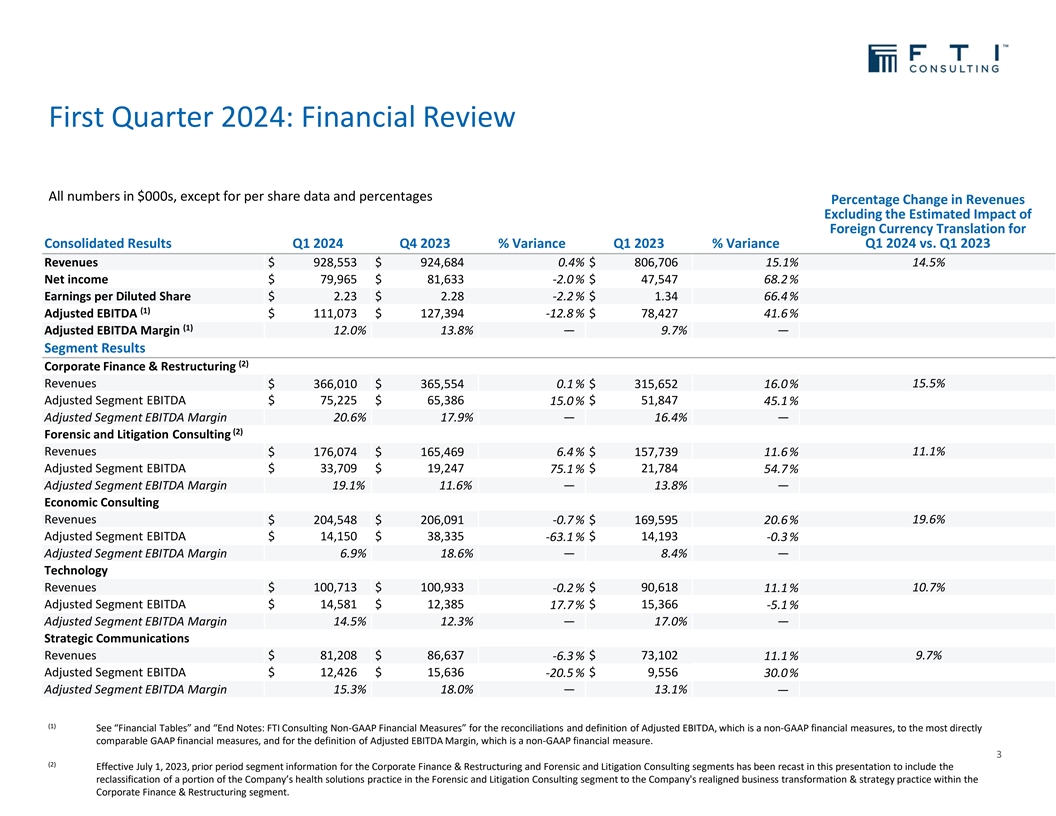
First Quarter 2024: Financial Review All numbers in $000s, except for per share data and percentages Percentage Change in Revenues Excluding the Estimated Impact of Foreign Currency Translation for Consolidated Results Q1 2024 Q4 2023 % Variance Q1 2023 % Variance Q1 2024 vs. Q1 2023 Revenues $ 928,553 $ 924,684 0.4% $ 806,706 15.1% 14.5% Net income $ 79,965 $ 81,633 -2.0 % $ 47,547 68.2 % Earnings per Diluted Share $ 2.23 $ 2.28 -2.2 % $ 1.34 66.4 % (1) Adjusted EBITDA $ 111,073 $ 127,394 -12.8 % $ 78,427 41.6 % (1) Adjusted EBITDA Margin 12.0% 13.8% — 9.7% — Segment Results (2) Corporate Finance & Restructuring Revenues $ 366,010 $ 365,554 0.1 % $ 315,652 16.0 % 15.5% Adjusted Segment EBITDA $ 75,225 $ 65,386 $ 51,847 15.0 % 45.1 % Adjusted Segment EBITDA Margin 20.6% 17.9% — 16.4% — (2) Forensic and Litigation Consulting Revenues $ 176,074 $ 165,469 6.4 % $ 157,739 11.6 % 11.1% Adjusted Segment EBITDA $ 33,709 $ 19,247 $ 21,784 75.1 % 54.7 % Adjusted Segment EBITDA Margin 19.1% 11.6% — 13.8% — Economic Consulting Revenues $ 204,548 $ 206,091 -0.7 % $ 169,595 20.6 % 19.6% Adjusted Segment EBITDA $ 14,150 $ 38,335 $ 14,193 -63.1 % -0.3 % Adjusted Segment EBITDA Margin 6.9% 18.6% — 8.4% — Technology Revenues $ 100,713 $ 100,933 -0.2 % $ 90,618 11.1 % 10.7% Adjusted Segment EBITDA $ 14,581 $ 12,385 $ 15,366 17.7 % -5.1 % Adjusted Segment EBITDA Margin 14.5% 12.3% — 17.0% — Strategic Communications Revenues $ 81,208 $ 86,637 -6.3 % $ 73,102 11.1 % 9.7% Adjusted Segment EBITDA $ 12,426 $ 15,636 $ 9,556 -20.5 % 30.0 % Adjusted Segment EBITDA Margin 15.3% 18.0% — 13.1% — (1) See “Financial Tables” and “End Notes: FTI Consulting Non-GAAP Financial Measures” for the reconciliations and definition of Adjusted EBITDA, which is a non-GAAP financial measures, to the most directly comparable GAAP financial measures, and for the definition of Adjusted EBITDA Margin, which is a non-GAAP financial measure. 3 (2) Effective July 1, 2023, prior period segment information for the Corporate Finance & Restructuring and Forensic and Litigation Consulting segments has been recast in this presentation to include the reclassification of a portion of the Company’s health solutions practice in the Forensic and Litigation Consulting segment to the Company's realigned business transformation & strategy practice within the Corporate Finance & Restructuring segment.
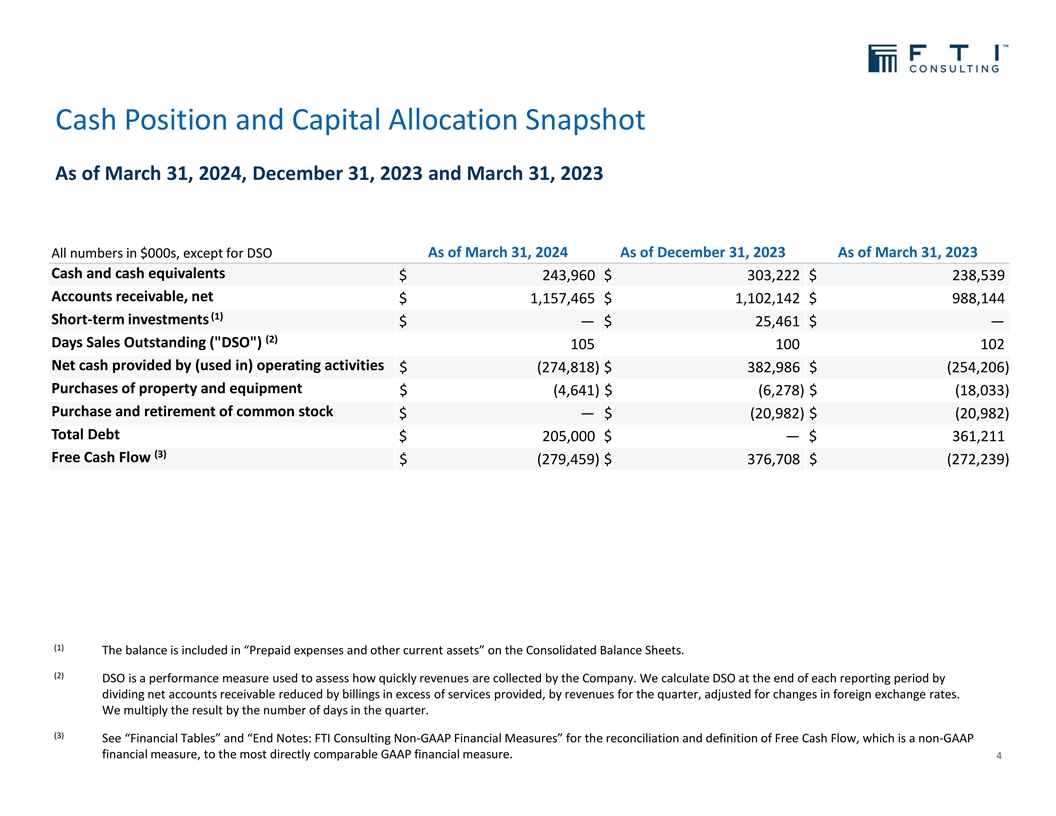
Cash Position and Capital Allocation Snapshot As of March 31, 2024, December 31, 2023 and March 31, 2023 All numbers in $000s, except for DSO As of March 31, 2024 As of December 31, 2023 As of March 31, 2023 Cash and cash equivalents $ 243,960 $ 303,222 $ 238,539 Accounts receivable, net $ 1,157,465 $ 1,102,142 $ 988,144 (1) Short-term investments $ — $ 25,461 $ — (2) Days Sales Outstanding ( DSO ) 105 100 102 Net cash provided by (used in) operating activities $ (274,818) $ 382,986 $ (254,206) Purchases of property and equipment $ (4,641) $ (6,278) $ (18,033) Purchase and retirement of common stock $ — $ (20,982) $ (20,982) Total Debt $ 205,000 $ — $ 361,211 (3) Free Cash Flow $ (279,459) $ 376,708 $ (272,239) (1) The balance is included in “Prepaid expenses and other current assets” on the Consolidated Balance Sheets. (2) DSO is a performance measure used to assess how quickly revenues are collected by the Company. We calculate DSO at the end of each reporting period by dividing net accounts receivable reduced by billings in excess of services provided, by revenues for the quarter, adjusted for changes in foreign exchange rates. We multiply the result by the number of days in the quarter. (3) See “Financial Tables” and “End Notes: FTI Consulting Non-GAAP Financial Measures” for the reconciliation and definition of Free Cash Flow, which is a non-GAAP financial measure, to the most directly comparable GAAP financial measure. 4

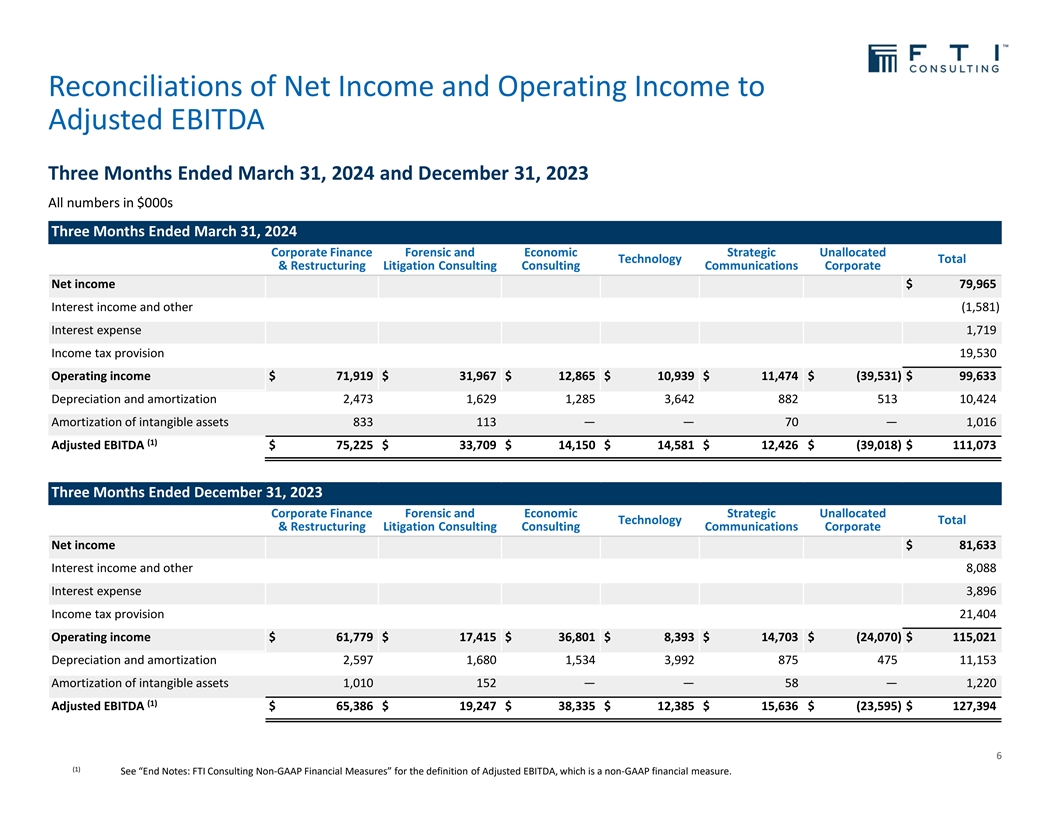
Reconciliations of Net Income and Operating Income to Adjusted EBITDA Three Months Ended March 31, 2024 and December 31, 2023 All numbers in $000s Three Months Ended March 31, 2024 Corporate Finance Forensic and Economic Strategic Unallocated Technology Total & Restructuring Litigation Consulting Consulting Communications Corporate Net income $ 79,965 Interest income and other (1,581) Interest expense 1,719 Income tax provision 19,530 Operating income $ 71,919 $ 31,967 $ 12,865 $ 10,939 $ 11,474 $ (39,531) $ 99,633 Depreciation and amortization 2,473 1,629 1,285 3,642 882 513 10,424 Amortization of intangible assets 833 113 — — 70 — 1,016 (1) Adjusted EBITDA $ 75,225 $ 33,709 $ 14,150 $ 14,581 $ 12,426 $ (39,018) $ 111,073 Three Months Ended December 31, 2023 Corporate Finance Forensic and Economic Strategic Unallocated Technology Total & Restructuring Litigation Consulting Consulting Communications Corporate Net income $ 81,633 Interest income and other 8,088 Interest expense 3,896 Income tax provision 21,404 Operating income $ 61,779 $ 17,415 $ 36,801 $ 8,393 $ 14,703 $ (24,070) $ 115,021 Depreciation and amortization 2,597 1,680 1,534 3,992 875 475 11,153 Amortization of intangible assets 1,010 152 — — 58 — 1,220 (1) Adjusted EBITDA $ 65,386 $ 19,247 $ 38,335 $ 12,385 $ 15,636 $ (23,595) $ 127,394 6 (1) See “End Notes: FTI Consulting Non-GAAP Financial Measures” for the definition of Adjusted EBITDA, which is a non-GAAP financial measure.
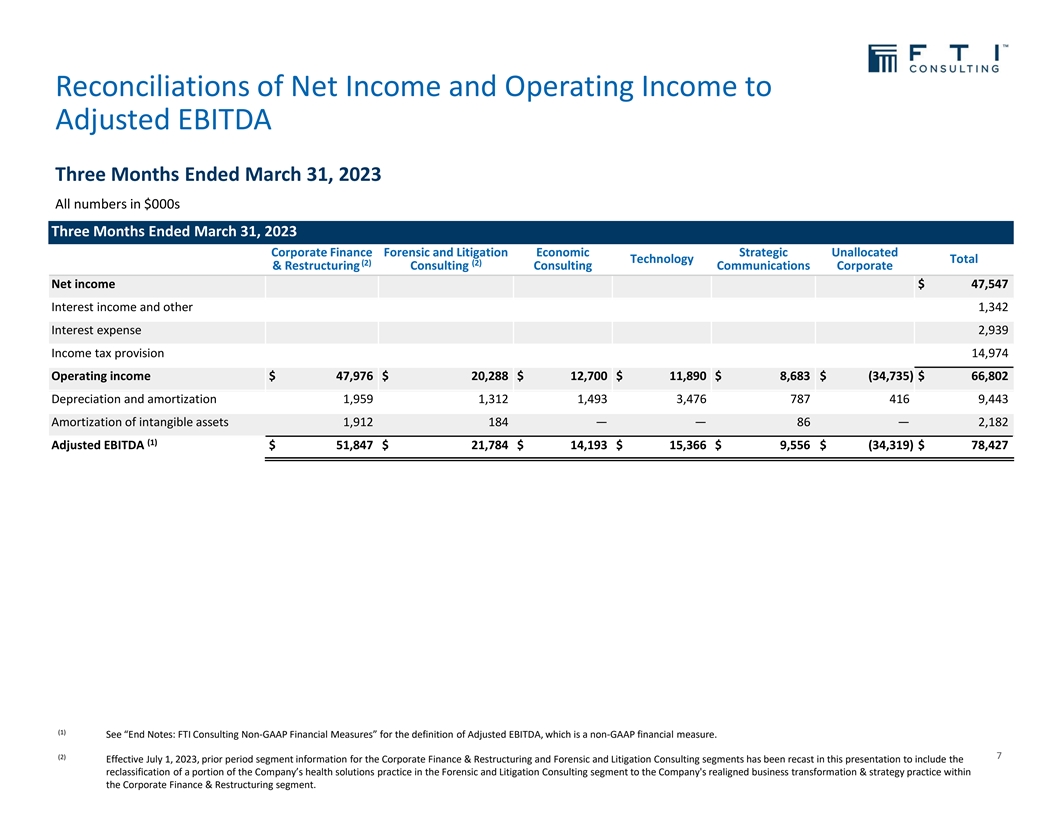
Reconciliations of Net Income and Operating Income to Adjusted EBITDA Three Months Ended March 31, 2023 All numbers in $000s Three Months Ended March 31, 2023 Corporate Finance Forensic and Litigation Economic Strategic Unallocated Technology Total (2) (2) & Restructuring Consulting Consulting Communications Corporate Net income $ 47,547 Interest income and other 1,342 Interest expense 2,939 Income tax provision 14,974 Operating income $ 47,976 $ 20,288 $ 12,700 $ 11,890 $ 8,683 $ (34,735) $ 66,802 Depreciation and amortization 1,959 1,312 1,493 3,476 787 416 9,443 Amortization of intangible assets 1,912 184 — — 86 — 2,182 (1) Adjusted EBITDA $ 51,847 $ 21,784 $ 14,193 $ 15,366 $ 9,556 $ (34,319) $ 78,427 (1) See “End Notes: FTI Consulting Non-GAAP Financial Measures” for the definition of Adjusted EBITDA, which is a non-GAAP financial measure. 7 (2) Effective July 1, 2023, prior period segment information for the Corporate Finance & Restructuring and Forensic and Litigation Consulting segments has been recast in this presentation to include the reclassification of a portion of the Company’s health solutions practice in the Forensic and Litigation Consulting segment to the Company's realigned business transformation & strategy practice within the Corporate Finance & Restructuring segment.
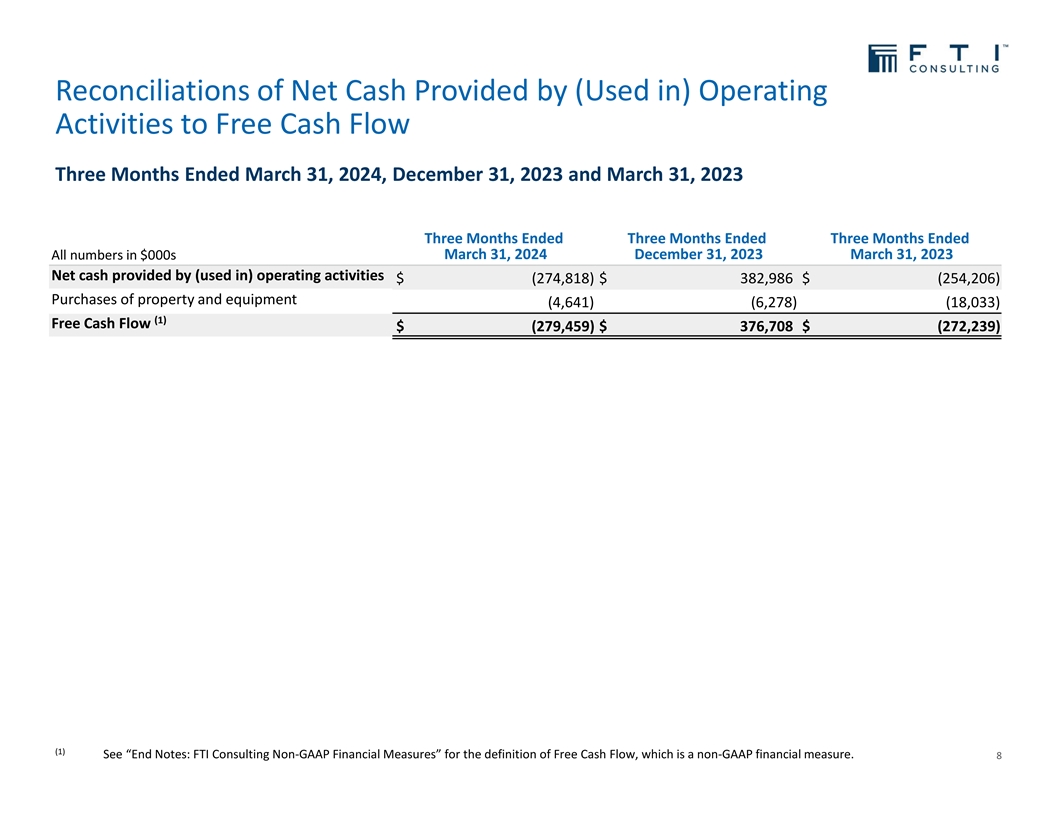
Reconciliations of Net Cash Provided by (Used in) Operating Activities to Free Cash Flow Three Months Ended March 31, 2024, December 31, 2023 and March 31, 2023 Three Months Ended Three Months Ended Three Months Ended All numbers in $000s March 31, 2024 December 31, 2023 March 31, 2023 Net cash provided by (used in) operating activities $ (274,818) $ 382,986 $ (254,206) Purchases of property and equipment (4,641) (6,278) (18,033) (1) Free Cash Flow $ (279,459) $ 376,708 $ (272,239) (1) See “End Notes: FTI Consulting Non-GAAP Financial Measures” for the definition of Free Cash Flow, which is a non-GAAP financial measure. 8
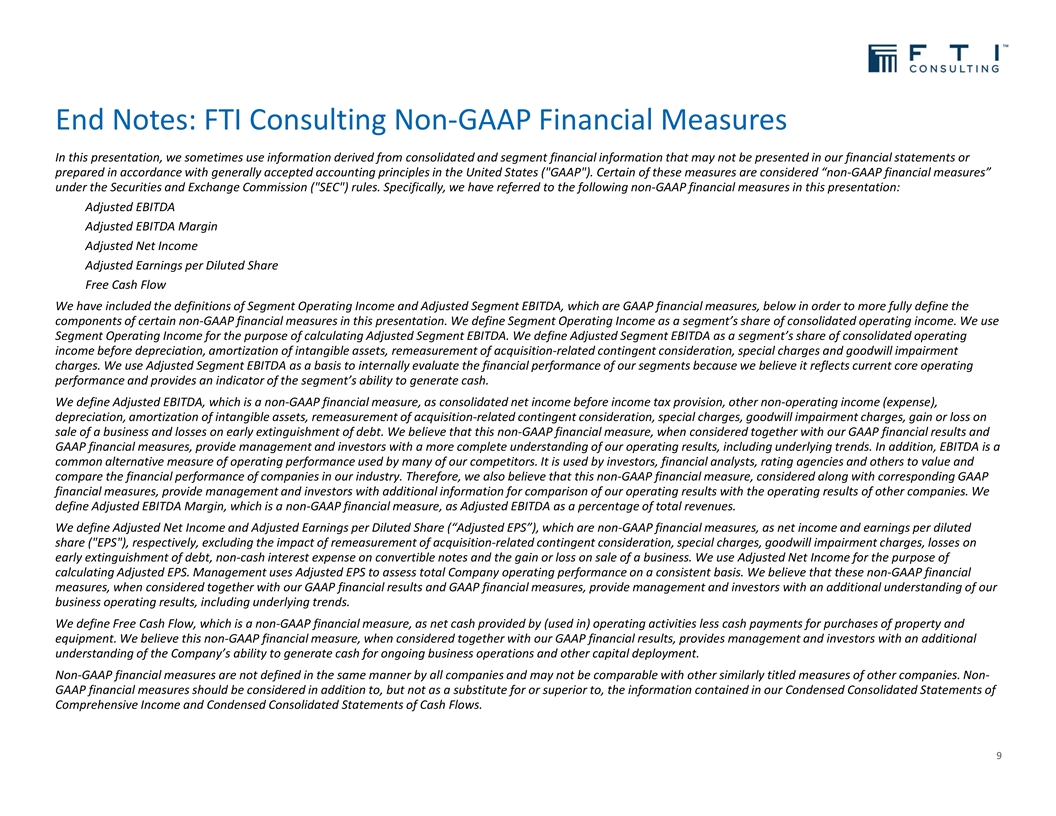
End Notes: FTI Consulting Non-GAAP Financial Measures In this presentation, we sometimes use information derived from consolidated and segment financial information that may not be presented in our financial statements or prepared in accordance with generally accepted accounting principles in the United States ( GAAP ). Certain of these measures are considered “non-GAAP financial measures” under the Securities and Exchange Commission ( SEC ) rules. Specifically, we have referred to the following non-GAAP financial measures in this presentation: Adjusted EBITDA Adjusted EBITDA Margin Adjusted Net Income Adjusted Earnings per Diluted Share Free Cash Flow We have included the definitions of Segment Operating Income and Adjusted Segment EBITDA, which are GAAP financial measures, below in order to more fully define the components of certain non-GAAP financial measures in this presentation. We define Segment Operating Income as a segment’s share of consolidated operating income. We use Segment Operating Income for the purpose of calculating Adjusted Segment EBITDA. We define Adjusted Segment EBITDA as a segment’s share of consolidated operating income before depreciation, amortization of intangible assets, remeasurement of acquisition-related contingent consideration, special charges and goodwill impairment charges. We use Adjusted Segment EBITDA as a basis to internally evaluate the financial performance of our segments because we believe it reflects current core operating performance and provides an indicator of the segment’s ability to generate cash. We define Adjusted EBITDA, which is a non-GAAP financial measure, as consolidated net income before income tax provision, other non-operating income (expense), depreciation, amortization of intangible assets, remeasurement of acquisition-related contingent consideration, special charges, goodwill impairment charges, gain or loss on sale of a business and losses on early extinguishment of debt. We believe that this non-GAAP financial measure, when considered together with our GAAP financial results and GAAP financial measures, provide management and investors with a more complete understanding of our operating results, including underlying trends. In addition, EBITDA is a common alternative measure of operating performance used by many of our competitors. It is used by investors, financial analysts, rating agencies and others to value and compare the financial performance of companies in our industry. Therefore, we also believe that this non-GAAP financial measure, considered along with corresponding GAAP financial measures, provide management and investors with additional information for comparison of our operating results with the operating results of other companies. We define Adjusted EBITDA Margin, which is a non-GAAP financial measure, as Adjusted EBITDA as a percentage of total revenues. We define Adjusted Net Income and Adjusted Earnings per Diluted Share (“Adjusted EPS”), which are non-GAAP financial measures, as net income and earnings per diluted share ( EPS ), respectively, excluding the impact of remeasurement of acquisition-related contingent consideration, special charges, goodwill impairment charges, losses on early extinguishment of debt, non-cash interest expense on convertible notes and the gain or loss on sale of a business. We use Adjusted Net Income for the purpose of calculating Adjusted EPS. Management uses Adjusted EPS to assess total Company operating performance on a consistent basis. We believe that these non-GAAP financial measures, when considered together with our GAAP financial results and GAAP financial measures, provide management and investors with an additional understanding of our business operating results, including underlying trends. We define Free Cash Flow, which is a non-GAAP financial measure, as net cash provided by (used in) operating activities less cash payments for purchases of property and equipment. We believe this non-GAAP financial measure, when considered together with our GAAP financial results, provides management and investors with an additional understanding of the Company’s ability to generate cash for ongoing business operations and other capital deployment. Non-GAAP financial measures are not defined in the same manner by all companies and may not be comparable with other similarly titled measures of other companies. Non- GAAP financial measures should be considered in addition to, but not as a substitute for or superior to, the information contained in our Condensed Consolidated Statements of Comprehensive Income and Condensed Consolidated Statements of Cash Flows. 9
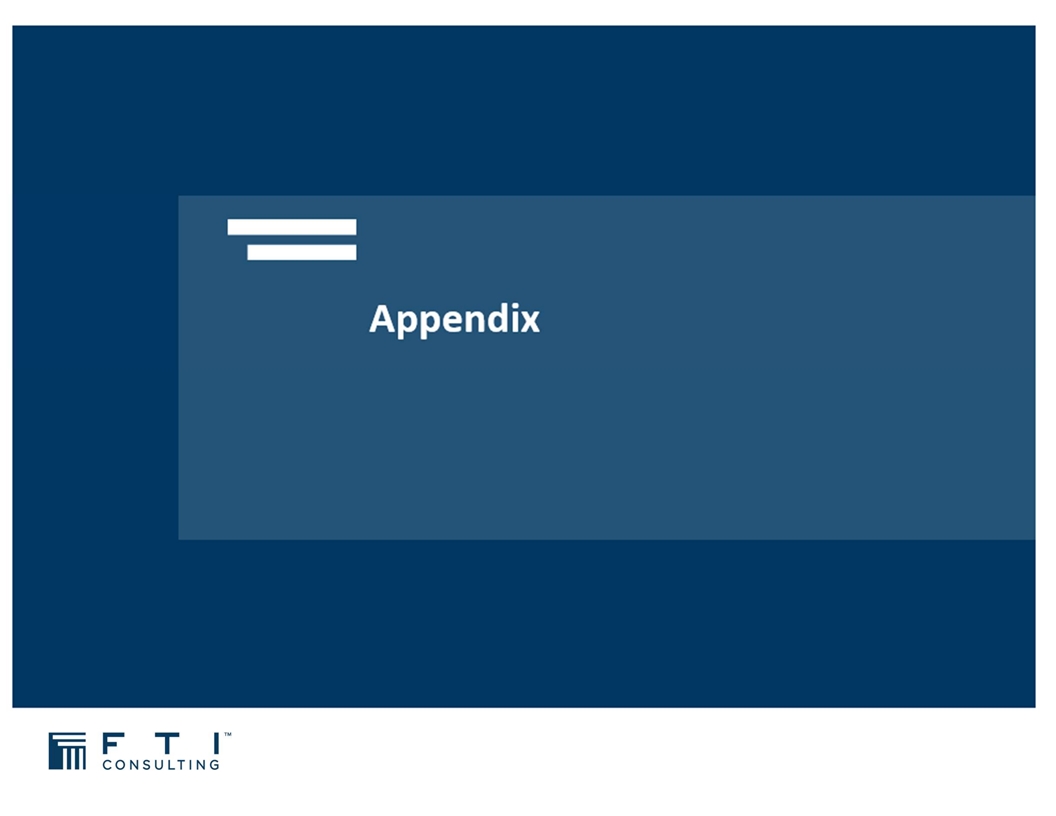
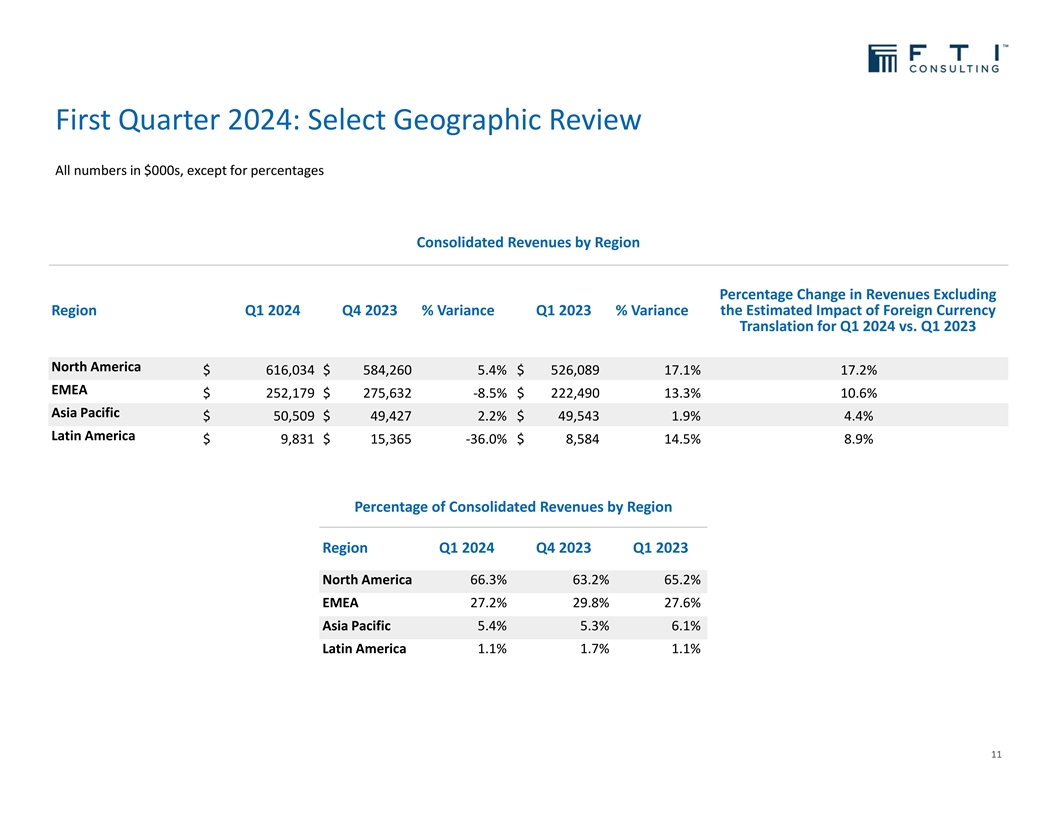
First Quarter 2024: Select Geographic Review All numbers in $000s, except for percentages Consolidated Revenues by Region Percentage Change in Revenues Excluding Region Q1 2024 Q4 2023 % Variance Q1 2023 % Variance the Estimated Impact of Foreign Currency Translation for Q1 2024 vs. Q1 2023 North America $ 616,034 $ 584,260 5.4% $ 526,089 17.1% 17.2% EMEA $ 252,179 $ 275,632 -8.5% $ 222,490 13.3% 10.6% Asia Pacific $ 50,509 $ 49,427 2.2% $ 49,543 1.9% 4.4% Latin America $ 9,831 $ 15,365 -36.0% $ 8,584 14.5% 8.9% Percentage of Consolidated Revenues by Region Region Q1 2024 Q4 2023 Q1 2023 North America 66.3% 63.2% 65.2% EMEA 27.2% 29.8% 27.6% Asia Pacific 5.4% 5.3% 6.1% Latin America 1.1% 1.7% 1.1% 11
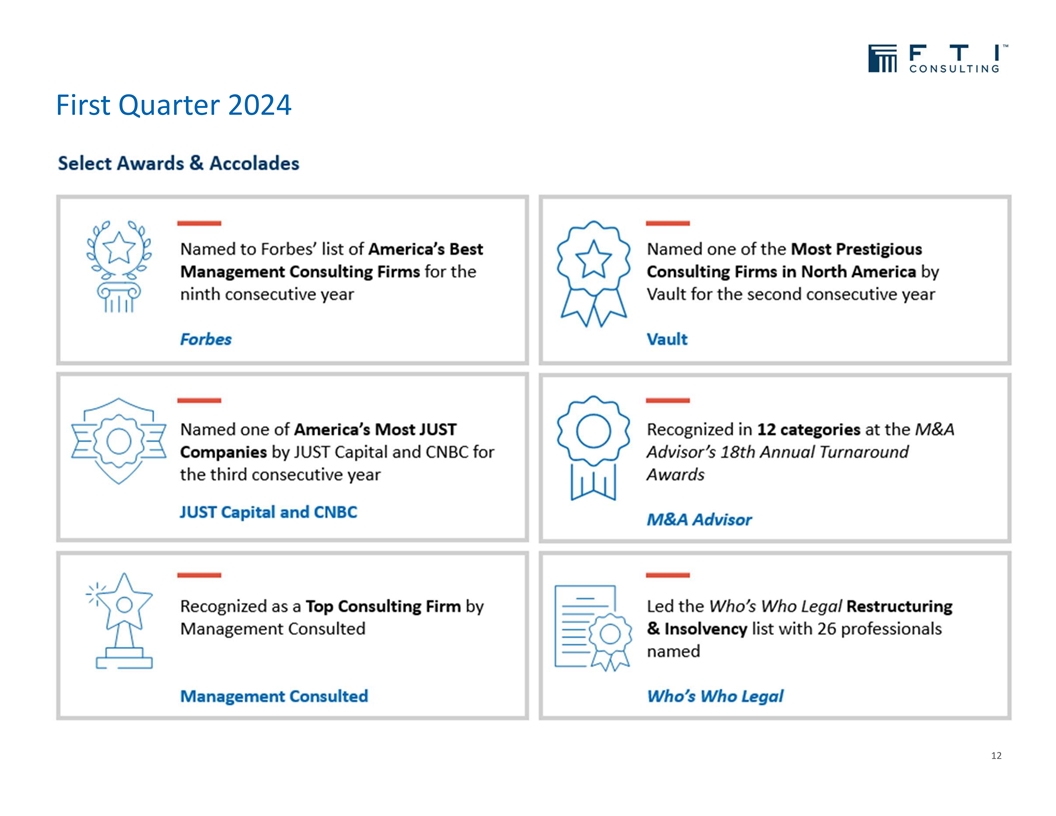
First Quarter 2024 12

TM Experts with Impact